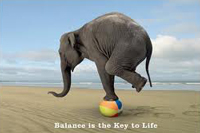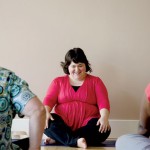by columnist Gabrielle Harris, The Suburban Yogini
Ever since I was publicly declared ‘unbalanced’ I got to thinking …… how can I go about getting my balance on?
Here is a sampler of treatments from the suburbs:
Therapy number one: Yin Yoga
After discovering that according to Ayurvedic science my dosha was pitta (fire and energy) I became aware that to find more balance in my life I needed to jump off the power yoga treadmill and sit on my butt for long periods of time letting my connective tissue be bathed in some nourishing fluid.
Yin yoga classes are a series of long held poses anywhere from 1-20 minutes. The theory behind yin is that the connective tissue around our joints and musculature is very dry or porous. The long holds give the body time to bath this tissue lubricating the joint. It has been compared to acupressure as it also stimulates chi or life energy in and around the body. This energy then flows like a river to areas of our body that are ‘stuck’ such as the hips and shoulders.
The yogis say the ‘issue is in the tissues’ which means that everything that we think, feel, say and do is stored in our body as emotional vibrations. After time these areas in our body become a storehouse or a reflection of our lives. We can become more balanced doing yin as it internally resets these storehouses by flushing out our imbalances while physically making us freer and more mobile.
Therapy number two: Thai massage
The massage incorporates yoga, acupressure and reflexology. It is similar to acupressure and shiatsu combined with stretches and yogic postures. The treatment involves the use of thumbs, fingers, knees, elbows and feet. The massage works on ‘sen lines’ similar to meridians which run throughout the human body. It aims to promote wellness and vitality by helping the body return to a state of balance and harmony.
A typical massage is 1-2 hours is done fully clothed and there are no oils used. My massage started with alot of acupressure into the soles of the feet plus compression it then travels up the thighs and lower legs. The massage then became more yoga like with backbends, hip openers and forward folds. I also had some lifting of my body to stretch out some of the muscle groups. The massage finished with some head work which put me into another place.
Interestingly the next day I felt like I had done a yoga workout. That feeling you get when you have worked your muscles. Hey, I might never need to go to a yoga class again!
If you haven’t experienced a Thai massage I recommend you do. You will absolutely feel balanced. It is the perfect massage to do if you are into yoga, or if you feel stressed and want to receive some love.
Therapy number three: Reiki
Reiki is a Japanese technique that treats the body, mind and spirit. It is based on the idea that distress in the body can be cured by increasing your body’s own life force energy. Reiki works on your entire system giving a sense of balance, security and well being.
A session of Reiki involves the client lying down in a warm, quiet, comfortable room. As session the client takes some deep breaths the therapist will gently guide their hands over the body checking the flow of energy. The therapist may from time to time lightly place their hands on the client (head, feet, shoulders) to increase the flow and movement of heat or energy so you may feel some general heat or no sensation at all.
I felt the warm sensation of having the hands pass over my body and could sense why this practice moves the energy around and out of the body where needed. When the practice had finished I found it VERY difficult to get off the table like I had been glued there.
Best suited for those recovering from surgery, illness or who are suffering from anxiety or stress. Interestingly after the treatment I kept thinking about things that came up, just some thoughts about areas in my life that I needed to work on. I thought that was a nice after affect of the massage.
Therapy number four: Direct Access Kinesiology
Kinesiology is a holistic complementary therapy that uses a client’s muscle response to gain insights into what is creating imbalance in the body. A Direct Access Kinesiologist treats mental, emotional and physical imbalances by working with the body’s innate intelligence via muscle tests. The practitioner can locate where and what is out of balance and also what priority techniques are needed for healing.
A number of healing modalities are drawn on in balances including Traditional Chinese Medicine, Life Coaching, Neuro-Linguistic Programing, Acupressure and energy healing. It is an incredibly gentle holistic therapy that can help anyone on their journey to health, happiness and wellbeing.
I have had three sessions to date and have to report that it has been fundamental in my becoming more aware of some repetitive thought patterns of mine that are quite frankly damaging. Every session I come away feeling much stronger and more focussed on what it is that I can do for myself each day to bring that little more softness and centre into my life. Highly recommended.
So, balance in effect is bringing yourself back from the edge to the center, finding the eye of the storm, or the still point. Balance is just imbalance repeated twice. Next time you are in tree pose watch how all the muscles in your ankle work to bring stability and you will understand that balance in your life is working with your imbalances and finding you centre ground.
If you would like more info on any of the types of practices, some reading material or contacts you can view a summary on my website.


Leave a Reply